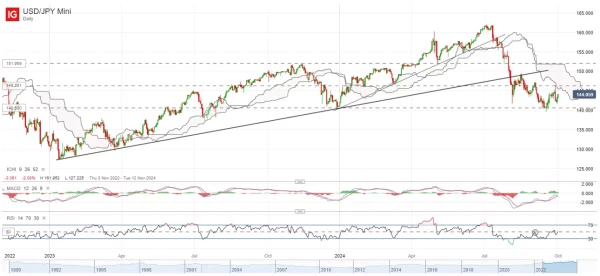Asia Day Ahead: What’s next for the USD/JPY?
Asia Open
The Asian session kicked off the new quarter on a slight breather, with Nikkei +1.31%, ASX -0.50% and NZX -0.13% at the time of writing. That said, weak seasonality has failed to stand in the way in the month of September, which reflected strong bullish views in place. We saw Wall Street powering on with its fifth straight month of gains while the MSCI Asia ex-Japan touched its highest level in more than two years.
Mainland China’s markets are off for holiday until 7 October, while Hong Kong and South Korean market are also offline today. Chinese equities have been a blowout on the raft of stimulus measures announced. We may expect markets to shrug off weak economic data for now, on the hopes that recent support should reflect some policy success over coming months. But whether the recovery will be a one-off adrenaline boost or a more sustained path, that will be a question for later. We have written about our call for the Hang Seng Index (HSI) last week: https://www.ig.com/sg/news-and-trade-ideas/what_s-next-for-the-hang-seng-index-with-recent-raft-of-chinas-s-240925.
On the other hand, Japanese equities have been more uncertain, as investors priced for a more hawkish outcome with its incoming prime minister, Mr Shigeru Ishiba. This is reflected in an initial strengthening of the yen, alongside an immediate downside reaction in Japanese equities. Views are that Mr Shigeru Ishiba may likely support the Bank of Japan (BoJ)’s hiking cycle fully, while advocating for fiscal discipline which will likely mean a tighter fiscal spending ahead.
Series of US economic data in focus this week
Overnight, Federal Reserve (Fed) Chair Jerome Powell maintained his view for two quarter-point rate cuts by the end of this year, seemingly a call for market expectations to be more aligned. His stance for a measured path of easing should continue to offer validation for the strength of the US economy, which will be welcomed by risk-on sentiments.
The risk to markets now is for policymakers to shift their views to guide for another jumbo cut in November or December, which will be deemed as a potential urgent reaction to economic risks. A series of US Purchasing Managers' Index (PMI) and labour market data will be in focus this week to move the dial around rate expectations. This will kickstart with the US ISM manufacturing PMI and job opening numbers tonight.
What’s next for the USD/JPY?
While the USD/JPY has pared some losses to start the new week, following some support for the US dollar on Fed Chair Jerome Powell’s less dovish remarks, we believe the broader downward trend for the USD/JPY may likely persist due to the following:
Thus far, US policymakers are firm on guiding for smaller 25 basis point (bp) moves over the next two meetings. We believe sentiments will be highly sensitive to any weaker-than-expected US data ahead, which will remain a drag on the US dollar. The upcoming release of the US ISM manufacturing PMI data could be a key risk, having underperformed for the past five straight months. US job additions have also came in lower-than-expected over the past two months.
On the Japan’s front, Mr Shigeru Ishiba has called for a snap election on 27 October instead of waiting until the end of the year. A quicker-than-expected election may allow Mr Ishiba to call for adjustment in policies at an earlier timing, which are likely to remind markets of his usual hawkish stance.
US-Japan yield differentials may continue to narrow, as the two central banks remain on a different policy path, which may remain a headwind for the USD/JPY. A trendline breakdown in June this year may mark a shift in broader trend to the downside (further narrowing to play out).
Technicals for the USD/JPY still lack bullish cues for now, with an upward trendline support being broken down in August this year, while its daily relative strength index (RSI) continues to trade below its mid-line.
Overall view: The 146.26 level may offer a resistance confluence to watch, which marked a horizontal support-turned-resistance, alongside its daily Ichimoku Cloud resistance. This level marked the initial sell-off reaction to the surprise outcome for Japan’s incoming PM and we believe taking up a short position around this level may be an attractive option, if the trend of lower highs were to be maintained. A close above 147.21 could invalidate the trade by reflecting buyers in greater control. Otherwise, trading in line with the broader downward trend could leave any subsequent breakdown of the 140.53 level on watch.
